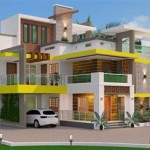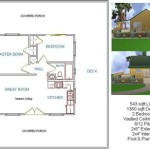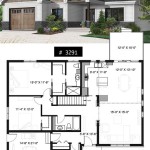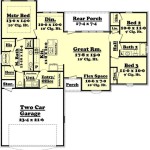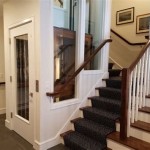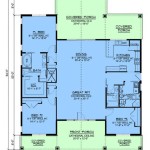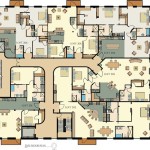Mid-Century Modern House Plans: A Timeless Vintage Appeal
Mid-Century Modern (MCM) architecture, a style flourishing from roughly 1945 to the mid-1960s, continues to captivate homeowners and design enthusiasts alike. Characterized by clean lines, a connection to nature, and functional simplicity, MCM houses represent a distinct departure from earlier architectural styles. The enduring appeal of vintage MCM house plans lies in their ability to blend seamlessly with contemporary lifestyles while retaining a sense of sophisticated nostalgia. Understanding the core principles and identifying key features within these plans is essential for appreciating and potentially recreating this iconic design aesthetic.
The resurgence of interest in MCM architecture stems from a desire for homes that are both aesthetically pleasing and practically designed. Post-war prosperity and technological advancements fueled a period of innovation in building materials and construction techniques, which are clearly reflected in MCM designs. These homes often feature open floor plans, large windows, and a focus on integrating the indoor and outdoor spaces. Vintage MCM house plans provide a valuable resource for those seeking to understand the original intent and execution of this influential architectural movement.
Defining Characteristics of Mid-Century Modern Architecture
The identification of specific characteristics is crucial to recognizing and appreciating the essence of MCM house plans. Several defining elements consistently appear across various designs from this era. These characteristics contribute to the overall aesthetic and functional appeal of the style.
One of the most recognizable features of MCM architecture is its emphasis on clean lines and geometric shapes. Simplicity is paramount, with a focus on horizontal lines, flat roofs, and minimal ornamentation. These elements contribute to a sense of visual clarity and order. The use of rectangular forms and asymmetrical compositions adds to the overall modernist aesthetic.
Another crucial aspect is the integration of nature. Large windows, sliding glass doors, and skylights are commonly incorporated to maximize natural light and provide expansive views of the surrounding landscape. This connection to the outdoors is further enhanced by the use of natural materials, such as wood, stone, and brick, in both the interior and exterior of the home. The goal is to create a seamless transition between the indoor and outdoor environments, blurring the boundaries between the two.
Functionality and practicality are also central to MCM design. Open floor plans promote a sense of spaciousness and encourage social interaction. Built-in storage solutions, such as cabinets and shelving, are often incorporated to maximize space and minimize clutter. The emphasis is on creating a comfortable and efficient living environment that caters to the needs of the modern family. The designs prioritize ease of living over excessive ornamentation or formality.
Key Elements Found in Vintage Mid-Century Modern House Plans
Delving deeper into vintage MCM house plans reveals specific elements that contribute to their unique character. These elements, ranging from structural components to interior details, are integral to understanding the overall design philosophy.
Rooflines in MCM architecture are typically low-pitched or flat, often with wide overhanging eaves. These eaves provide shade and protect the exterior walls from the elements. Butterfly roofs, characterized by their inverted V-shape, are another distinctive feature found in some MCM designs. These rooflines not only contribute to the aesthetic appeal of the home but also serve a functional purpose by channeling rainwater away from the building.
The use of post-and-beam construction is another hallmark of MCM architecture. This structural system allows for large, open spaces and expansive window walls. The exposed beams add a visual element of warmth and texture to the interior. The post-and-beam construction also enables greater flexibility in the layout and design of the home.
Interior layouts in MCM homes are often characterized by open floor plans that seamlessly connect the living, dining, and kitchen areas. This open concept promotes a sense of spaciousness and encourages social interaction. The kitchen is typically integrated into the main living area, reflecting the changing roles of women in the post-war era and the desire for a more informal and family-centered lifestyle.
Vintage MCM house plans frequently incorporate elements of biophilic design, which emphasizes the connection between humans and nature. This is achieved through the use of natural materials, abundant natural light, and views of the surrounding landscape. Indoor plants are often incorporated into the design to further enhance the connection to nature and improve indoor air quality.
Interpreting and Adapting Vintage MCM House Plans for Modern Living
While vintage MCM house plans offer a wealth of inspiration and design ideas, adapting them for contemporary living requires careful consideration. Modern homeowners often seek to incorporate updated technologies, improved energy efficiency, and personalized design elements while preserving the integrity of the original MCM aesthetic.
One of the primary considerations when adapting a vintage MCM house plan is ensuring compliance with current building codes and regulations. This may involve structural modifications, updates to electrical and plumbing systems, and improvements to insulation and energy efficiency. Consulting with a qualified architect or engineer is essential to ensure that the adapted plan meets all applicable requirements.
Integrating modern technologies into a vintage MCM home can be achieved in a way that complements the original design. Smart home systems, energy-efficient appliances, and updated lighting fixtures can be seamlessly incorporated without compromising the aesthetic appeal of the home. Concealing wiring and integrating technology into built-in cabinetry can further minimize the visual impact of modern amenities.
Improving energy efficiency is a key priority for many homeowners. Upgrading insulation, replacing windows with energy-efficient models, and installing solar panels can significantly reduce energy consumption and lower utility bills. These improvements can be made in a way that is sensitive to the original design, preserving the aesthetic integrity of the home while enhancing its environmental performance.
Personalizing a vintage MCM house plan to reflect individual tastes and preferences is an important aspect of the adaptation process. While preserving the overall aesthetic, homeowners can incorporate their own design elements through the selection of furniture, finishes, and accessories. Choosing materials and colors that are consistent with the MCM aesthetic can help to maintain the overall harmony of the design.
Sourcing original or reproduction MCM furniture and décor can further enhance the authenticity of the home. Many vintage furniture pieces are available through antique stores, online marketplaces, and estate sales. Reproduction furniture and décor are also widely available, offering a more affordable and accessible option for those seeking to recreate the MCM aesthetic.
Adapting vintage MCM house plans for modern living requires a careful balance between preserving the original design intent and incorporating contemporary amenities and technologies. By understanding the core principles of MCM architecture and working with qualified professionals, homeowners can successfully transform a vintage plan into a comfortable, functional, and aesthetically pleasing living space.
The enduring appeal of vintage MCM house plans lies in their ability to offer a timeless and sophisticated aesthetic that resonates with contemporary lifestyles. By understanding the defining characteristics and key elements of these plans, homeowners can appreciate the architectural significance of this influential design movement and successfully adapt them for modern living.

Untitled Modern Floor Plans Mid Century House

Untitled Mid Century Modern House Plans Floor

Nps Plan Belville 1952 Mid Century Modern House Plans

See 125 Vintage 60s Home Plans Used To Design Build Millions Of Mid Century Houses Across America Americana

Vintage House Plans 1153 1960s Modern Floor

84 Original Retro Midcentury House Plans That You Can Still Buy Today Renovation

Untitled Modern Floor Plans Vintage House Mid Century

Mid Century Modern Homes Sgf

55 Mcm Vintage House Plans Ebook Instant Digital

Build A House With These Mid Century Modern Floor Plans Blog Eplans Com

